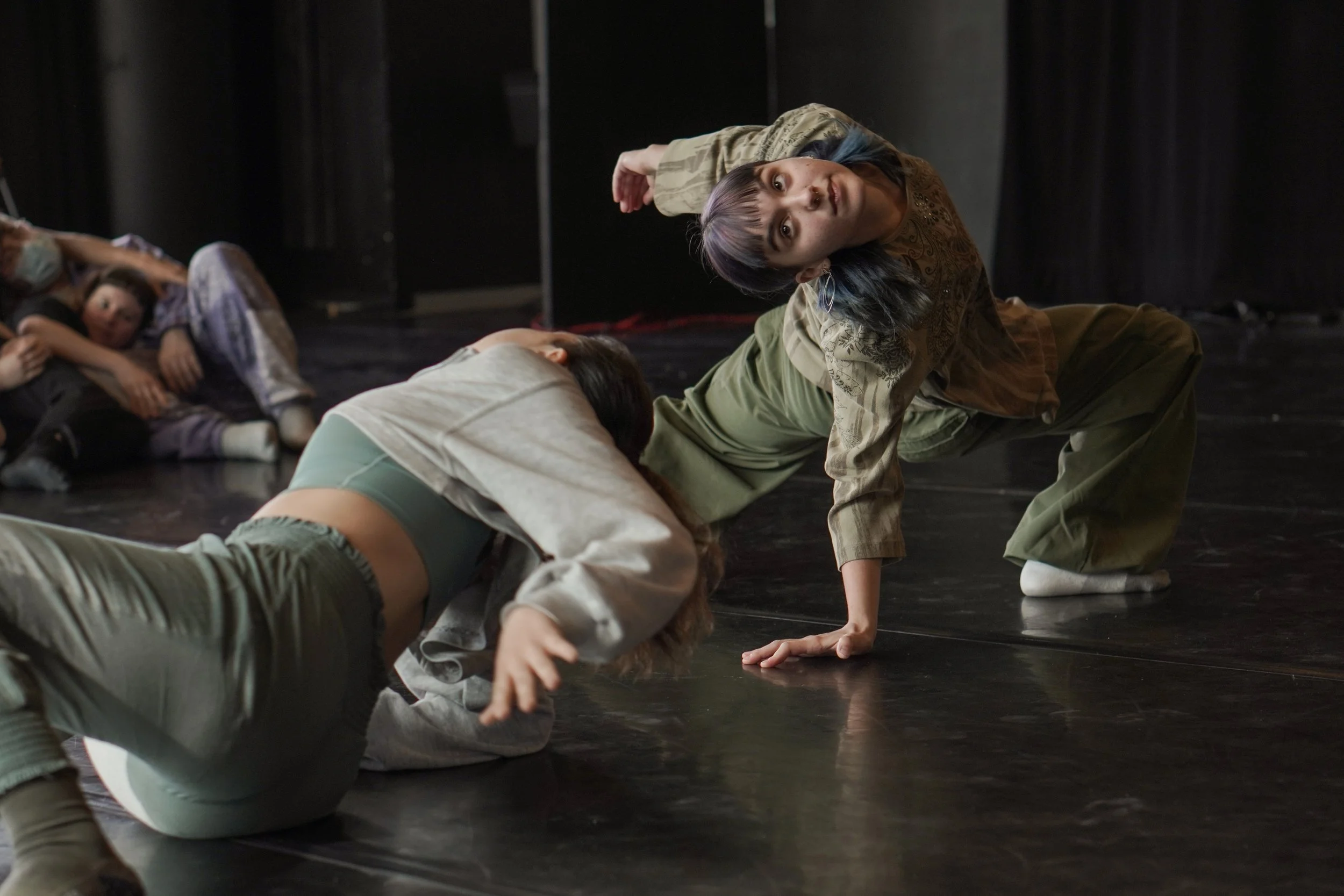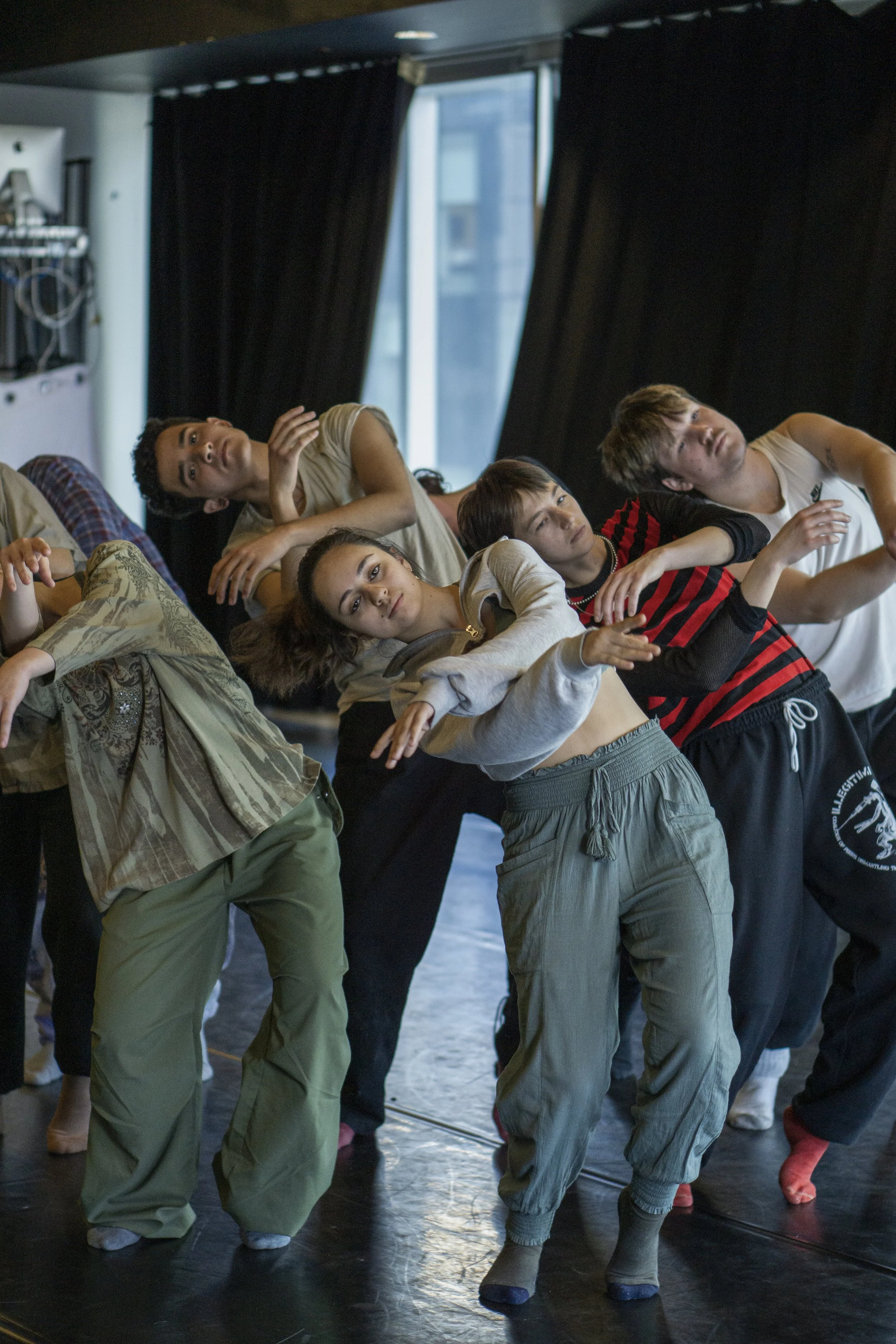Spirale 2023 - A Review of Fragments éphémères
Photo by Kristina Hillard
Here I was, going up to the seventh floor of Concordia’s JMSB building for the millionth time. Shared between the theater and dance departments, it is the creative gem of a serious building built for business students. Over the course of three years, I had become accustomed to that floor. I knew to turn towards the theater studios, readying myself for the glorious world of self reflection. Turning left also meant interrupting heartfelt conversations in socks or squeezing past class run corridor expeditions. This time I was going a different direction, one that belonged to the dance department. I was daring to turn right.
I was going to see Fragments éphémères, a first year contemporary dance show created and performed by Allyss, Emine Adilak, Élisabeth Bergeron, Ashlee Gemberling, Liam Gover, Zachary Lagha, Santiago Lopez Alzate, Mia Catherine Pereira, Solen Rios, and Nicki White, presented in the context of the yearly Spirale production. Helen Simard, the artist-in-residence, had agreed to chat with me for a couple minutes before the start time. I had heard of her as a choreographer, rehearsal director, and dramaturge, yet this was our first time meeting face-to-face. She wasn’t hard to spot and greeted me with a confident smile. She was in the process of choosing some “elevator music”, as she joked, to make waiting more welcoming for those who were coming to see the same performance as I was. We walked to a bench nearby to sit and chat about the rehearsal process. I didn’t know where to start. What were your warm-ups like? How did you go about teaching dramaturgy? Were there any moments of “clashing”? Why were beads mentioned in the program? I finally landed on asking about the dramaturgical process of this piece and left it there. It floated between us for a second. I waited. She repositioned her body to sit more comfortably. She turned to face me, looked me in the eyes and answered like a friend.
They began their process knowing they would create an outcome together. An outcome, not a final performance. I had first learned of that concept in my first year. My professor at the time explained that we were not creating a show in the way we understood it. As a group, we were there to create something that reflected our trials and our learning process; a looking glass of sorts into our rehearsal space. Helen Simard approached their outcome as being a show that is a living, breathing thing in a constant state of renewal. It lives in a raw state of exploration and intentional incompleteness. They navigated observing, spectating and performing within their common objective of creating an outcome. With various levels of experience and dance backgrounds, they were all taught to use common language that focused on one thing: What serves the work? Keeping this question in a creative space is harder than it seems due to our biggest human downfall. Ego.
She pointed out that in general, the dramaturgical process is partly about the offering of something that may or may not be agreed upon. With this, it’s important to reflect on your possible perception of micro-rejections. I couldn’t help but nod in agreement. It was nice to hear Helen Simard acknowledge that as well and speak on her resolution of conflict within this group.
I strongly felt that Helen had given them the valuable opportunity to learn how to be efficient communicators in a creative, collaborative environment. Within this, she allowed them to make mistakes and to correct them. As I heard her speak, there were an abundance of parallels with my own practice of devised theater which I had come to love over the years. I could feel that in our respective programs, we were learning a lot of the same thing but in different fonts.
We had to cut our chat short as the hallway started to fill with the familiar “Hey, ça va?” of old friends. We said our goodbyes, and I sat there a minute to gather my thoughts. When I finished jotting down some notes, I looked up in hopes of finding a familiar face. I caught on fairly quickly that most of those attending knew each other: Fellow dance students, family, and department staff. It was nice to hear them catch up.
I took off my shoes like everyone else in line to go into the black box. The doors opened and I walked in, choosing a seat a little further out. I noticed that there were seats surrounding where they were going to perform. Soon after, the lights dimmed and it was already show time.
Music, breathing, repetition. Some moved, some held each other, some stood and watched. Everything about this was intimate. I was witnessing vulnerability and leadership in its purest form through the giving and taking of space. They moved for and with each other both seriously and playfully. I saw poems of love, of support, of challenges. I sat there and felt very lucky that I was kind of part of it too by just being there.
The energy of the outcome came in waves. One minute I was watching a show, and the other I was sitting in their rehearsals. There is one moment that stood out to me the most, my favorite one of all. It started with a few giggles, a few questions. They laughed, they stretched, they talked. As this went on, their words slowly bled into long embraces. The performers thanked each other through the warmth of heartfelt hugs. Suddenly, we existed in that black box with them as they approached their friends in the audience for a hug. Engulfed in the world they had created together, I was surprised to find that I wanted one too. It was destabilizing in a good way.
When the show ended, my heart was full of love and gratitude for strangers. Their creative approach was very familiar and nostalgic. I knew this space and have been in it.
The performers all pitched in to clear the space they had worked in, like a closing ritual of some sorts. I watched as they folded chairs and put away some mats, while chatting away about their last show together. In fear of interrupting them, I grabbed my bag to get out of the way. I was lucky enough to bump into Santiago Lopez Alzate in the corridor. He was generous enough to give me some quick insight on his learning of dramaturgy within this class. Santiago mentioned that he learned how to take more space. In turn, it felt nice to feel his friends offer to hold that space for him in response. I thanked him for his time and he quickly left to join his group in the now empty studio for their final closing.
I slipped on my boots, zipped up my coat, and headed back to the elevator before it hit me. I finally understood the reference to beads from the program. How do random beads string together, despite their individual differences? I now had an answer. Through their love for each other, through their self awareness, and through their shared language, these wonderful collaborators had been guided to glue different pieces of themselves into something beautiful, giving, and warm.
Photos by Kristina Hillard






